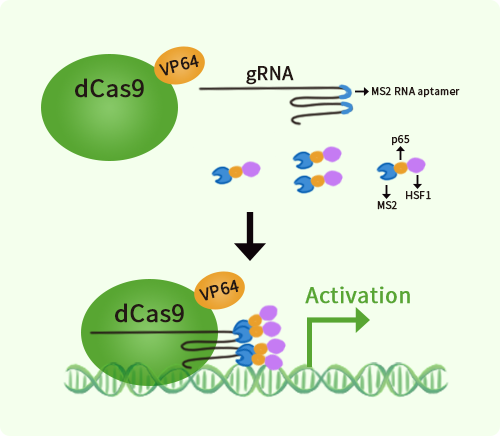Human Cyclin E1 (CCNE1) activation kit by CRISPRa
CAT#: GA100629
CCNE1 CRISPRa kit - CRISPR gene activation of human cyclin E1
Find the corresponding CRISPRi Inhibitor Kit
USD 1,290.00
2 Weeks*
Specifications
| Product Data | |
| Format | 3gRNAs, 1 scramble ctrl and 1 enhancer vector |
| Symbol | CCNE1 |
| Locus ID | 898 |
| Kit Components | GA100629G1, Cyclin E1 gRNA vector 1 in pCas-Guide-GFP-CRISPRa GA100629G2, Cyclin E1 gRNA vector 2 in pCas-Guide-GFP-CRISPRa GA100629G3, Cyclin E1 gRNA vector 3 in pCas-Guide-GFP-CRISPRa 1 CRISPRa-Enhancer vector, SKU GE100056 1 CRISPRa scramble vector, SKU GE100077 |
| Disclaimer | The kit is designed based on the best knowledge of CRISPa SAM technology. The efficiency of the activation can be affected by many factors, including nucleosome occupancy status, chromatin structure and the gene expression level of the target, etc. |
| Reference Data | |
| RefSeq | NM_001238, NM_001322259, NM_001322261, NM_001322262, NM_057182 |
| Synonyms | CCNE; pCCNE1 |
| Summary | 'The protein encoded by this gene belongs to the highly conserved cyclin family, whose members are characterized by a dramatic periodicity in protein abundance through the cell cycle. Cyclins function as regulators of CDK kinases. Different cyclins exhibit distinct expression and degradation patterns which contribute to the temporal coordination of each mitotic event. This cyclin forms a complex with and functions as a regulatory subunit of CDK2, whose activity is required for cell cycle G1/S transition. This protein accumulates at the G1-S phase boundary and is degraded as cells progress through S phase. Overexpression of this gene has been observed in many tumors, which results in chromosome instability, and thus may contribute to tumorigenesis. This protein was found to associate with, and be involved in, the phosphorylation of NPAT protein (nuclear protein mapped to the ATM locus), which participates in cell-cycle regulated histone gene expression and plays a critical role in promoting cell-cycle progression in the absence of pRB. [provided by RefSeq, Apr 2016]' |
Documents
| Product Manuals |
| FAQs |
Resources
Other Versions
| SKU | Description | Size | Price |
|---|---|---|---|
| KN404289 | CCNE1 - KN2.0, Human gene knockout kit via CRISPR, non-homology mediated. |
USD 1,290.00 |
{0} Product Review(s)
Be the first one to submit a review






























































































































































































































































 Germany
Germany
 Japan
Japan
 United Kingdom
United Kingdom
 China
China
